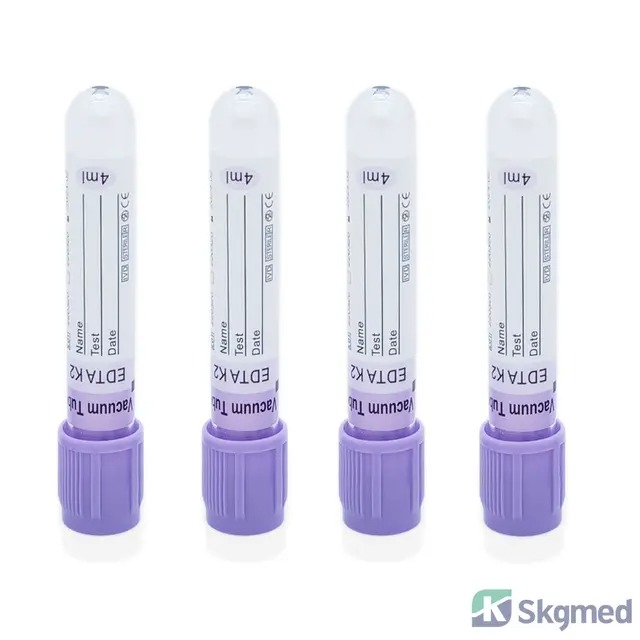In healthcare, precision is everything, and vacuum blood collection tubes play a critical role in ensuring that every blood sample collected for testing is handled accurately. These small yet essential devices are used in labs and clinics to collect blood efficiently while maintaining the sample's integrity. In this article, we’ll explore what these tubes are, how they work, and why they are a must-have in modern diagnostics.
How Do They Work? The Science of Suction
Precise Blood Collection Every Time
Vacuum blood collection tubes use pre-evacuated technology to create a controlled vacuum inside the tube. This vacuum gently draws the exact amount of blood needed when the needle is inserted, ensuring that the sample volume is consistent every time. This eliminates the risk of under- or over-collection, which is crucial for obtaining reliable test results.
Protecting the Sample: Minimal Risk of Hemolysis
The controlled vacuum not only ensures the right blood volume but also minimizes the risk of hemolysis (destruction of red blood cells). By preventing excessive suction or agitation, these tubes maintain the sample’s integrity, ensuring that the blood is intact and suitable for analysis.

Types of Vacuum Blood Collection Tubes
1. EDTA Tubes: Hematology’s Essential
EDTA blood collection tubes are designed for whole blood analysis. The EDTA additive binds calcium ions, which prevents clotting, ensuring that blood cells remain stable for up to 24 hours. These tubes are commonly used for tests like complete blood counts (CBCs), blood smears, and other hematology tests.
2. Serum Separator Tubes (SST): Serum in a Flash
For tests that require serum, such as liver and kidney function tests, serum separator tubes (SST) are ideal. These tubes contain a gel that separates serum from blood cells during centrifugation, ensuring a clean, contaminant-free sample for testing.
3. Heparin Tubes: Plasma in No Time
When plasma is needed quickly, heparin blood collection tubes are the best choice. Heparin works by inhibiting thrombin, preventing clotting. These tubes are perfect for tests like metabolic panels and drug screening, where plasma is essential for accurate results.
4. Citrate Tubes: For Coagulation Studies
For tests that measure the blood's clotting ability, like prothrombin time (PT) and activated partial thromboplastin time (APTT), sodium citrate tubes are the go-to choice. Citrate prevents clotting by binding calcium, allowing precise testing of coagulation factors.
5. Plain Serum Tubes: Simple and Effective
Plain serum tubes are used for tests like blood typing and hormone assays. These tubes allow blood to clot naturally, and after centrifugation, the serum is separated, making them ideal for tests that don’t require anticoagulation.
Why Choose Vacuum Blood Collection Tubes?
1. Precision: Accuracy in Blood Volume
One of the key benefits of vacuum blood collection tubes is the precise control they offer in drawing blood. The pre-evacuated vacuum ensures that the exact amount of blood is collected every time, eliminating the risk of over- or under-collection, which is essential for accurate test results.
2. Minimized Hemolysis: Protecting Sample Integrity
Vacuum blood collection tubes help minimize hemolysis by gently drawing blood, avoiding the aggressive suction that can break red blood cells. This ensures that the sample remains intact and is suitable for testing, which is critical for reliable results.
3. Efficiency: Streamlined Collection
Using vacuum blood collection tubes makes the blood collection process quicker and more efficient. The tubes eliminate the need for additional suction devices or manual intervention, speeding up the procedure in busy environments like emergency rooms or clinics.
4. Leak-Proof Design: Sample Security
Many vacuum blood collection tubes are equipped with leak-proof caps, ensuring that blood samples remain intact during transport and storage. This helps protect the sample from contamination and guarantees it reaches the lab in optimal condition.
5. Automation-Ready: Smooth Laboratory Integration
With standardized sizes and color-coded caps, vacuum blood collection tubes are designed to work seamlessly with automated laboratory systems. This integration streamlines lab workflows, reduces human error, and accelerates the testing process.
Where Are Vacuum Blood Collection Tubes Used?
Hematology: Whole Blood Analysis
EDTA blood collection tubes are crucial for hematology tests like CBCs and blood smears. They ensure the blood cells remain intact, providing reliable data for diagnosing blood-related conditions.
Clinical Chemistry: Serum and Plasma Testing
From liver function tests to metabolic panels, vacuum blood collection tubes with additives like gel separators or heparin ensure that serum or plasma is separated cleanly for testing, with minimal risk of contamination.
Coagulation Studies: Accurate Clotting Tests
For monitoring coagulation, sodium citrate tubes are essential. These tubes ensure that blood remains in its liquid form, making them critical for testing clotting factors and managing patients on anticoagulant therapy.
Blood Banking: Safe Blood Storage
In blood banking, vacuum blood collection tubes help collect and preserve blood for donation or transfusion. By preventing clotting with EDTA or heparin, these tubes make it possible to conduct compatibility testing and ensure safe blood transfusions.
Why Trust Vacuum Blood Collection Tubes?
Whether you need EDTA tubes, serum separator tubes, or heparin tubes, vacuum blood collection tubes offer a reliable and efficient solution for blood sample collection. They are the gold standard for ensuring diagnostic accuracy, minimizing errors, and preserving sample integrity. Choose the best tool for your diagnostic work and experience a smoother, more reliable blood collection process.
Conclusion
From hematology to blood banking, vacuum blood collection tubes are indispensable in modern diagnostics. With their precise blood collection, minimized risk of hemolysis, and ability to streamline workflows, these tubes are critical for accurate and efficient lab testing. Choose vacuum blood collection tubes for high-quality, reliable blood sample collection that ensures every test counts.
















